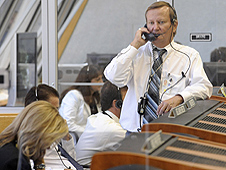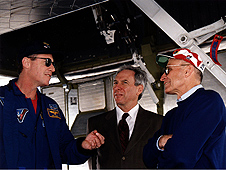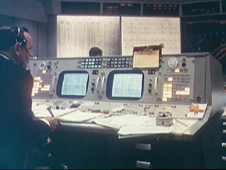Feature
What Makes a Launch Director (Part One)
06.16.08
 Mike Leinbach, standing, became shuttle launch director in 2000. Leinbach said it is critical that launch directors convey calm to the launch team so that any problems can be assessed and corrected properly without someone rushing past something. Photo credit: NASA/Bill Ingalls
Mike Leinbach, standing, became shuttle launch director in 2000. Leinbach said it is critical that launch directors convey calm to the launch team so that any problems can be assessed and corrected properly without someone rushing past something. Photo credit: NASA/Bill Ingalls View Hi-Res Image
 Bob Sieck, right, talks with space shuttle commander Michael Baker, left, and then-NASA Administrator Dan Goldin on the Shuttle Landing Facility runway. Sieck managed 52 space shuttle launches and was involved with spaceflight since the Gemini program. Photo credit: NASA
Bob Sieck, right, talks with space shuttle commander Michael Baker, left, and then-NASA Administrator Dan Goldin on the Shuttle Landing Facility runway. Sieck managed 52 space shuttle launches and was involved with spaceflight since the Gemini program. Photo credit: NASA View Hi-Res Image
 Chris Kraft oversaw the countdowns of NASA's Mercury program. At that time, launch and mission control operations were conducted at Cape Canaveral Air Force Station. Photo credit: NASA
Chris Kraft oversaw the countdowns of NASA's Mercury program. At that time, launch and mission control operations were conducted at Cape Canaveral Air Force Station. Photo credit: NASAView Hi-Res Image
Many people think the launch director's job is to get the space shuttle off the ground. It isn't.
"The launch director's job is to not launch the space shuttle," said Mike Leinbach. He would know. Leinbach has been the Shuttle Launch Director at NASA's Kennedy Space Center for the last eight years.
As the last decision-maker before the space shuttle engines and boosters ignite, it is the launch director's responsibility to say "no" if everything doesn't look and feel exactly right. Even when the rest of the launch team says "go."
"It's the job to stay on the ground if we're not ready to go," Leinbach explained.
Former launch director Bob Sieck made that decision a couple of times during the course of overseeing more than 50 space shuttle launches.
Weather prompted one of those decisions, even though the forecast was green.
"I went outside and I saw the clouds pop up here and there," he said. "My training said, nope, it's not good enough. You could hear the moan go up in the control room. Nobody keyed their mikes, but you could hear it."
Leinbach calls the trait "calm assuredness" and said it is essential to anyone who wants to lead the shuttle launch team. Part of it is confidence and the other is a natural reserve that keeps a launch director from getting excited, even during times that would send many managers into fits.
"The calm assuredness is really key because if we're working something late and we're bumping against the clock, the last thing a launch director should do is have any kind of immediacy in his voice," Leinbach said. "You have to let the process play out. You can help the process along, but you don't want to come across as being rushed."
Adding to the pressure is the enormity of the stage. The launch director is a focal point during countdown and his words are often transmitted live and played over and over.
"You have to be able to approach the problem as if the world wasn't watching," Sieck said.
Although he is the leader of the launch team, the director also knows the value of a highly skilled and thoroughly trained group of test directors, test conductors, system engineers, and safety and quality professionals.
"The team is outstanding and will never allow me to feel like I’m in over my head," Leinbach said.
That doesn't mean there are not some anxious or nervous feelings, especially at first, but training usually takes care of those long before launch day.
The Kennedy launch team typically goes through two simulated countdowns before launch day. The whole group of test directors, controllers and engineers work through the same processes as launch day, but there's 25 to 30 manufactured problems thrown into the mix.
"You've got to let the team make some mistakes," Leinbach said. "In any walk of life, the best way to learn something is to make a mistake, correct it, and move on. On training days, I'll let the team make some pretty significant mistakes."
The confidence comes in part from personality, but it also is the result of years of intensely studying how spacecraft systems operate and how they impact other systems.
"I tell everybody I am not a system expert in any particular system, but I do know all the systems well enough to know how they behave, and how they interrelate," Leinbach said.
Chris Kraft, who oversaw NASA's earliest crewed launches, said that skill has always been essential to a launch director's resume.
"You have to understand orbital mechanics, at least as far as what it's going to do if you miss the prime launch time," Kraft said. "And at the same time understand the parameters necessary for proper photography, the necessary winds and the abort requirements."
A focus on safety is the common thread that runs through all past and present launch directors and everyone on the launch team, Kraft believes.
"I think they're pretty dedicated people making sure it's going to be a damn safe ride for the crew," he said. "You always wanted to make sure it was as perfect a vehicle as you could make it."
› Read Part Two
NASA's John F. Kennedy Space Center